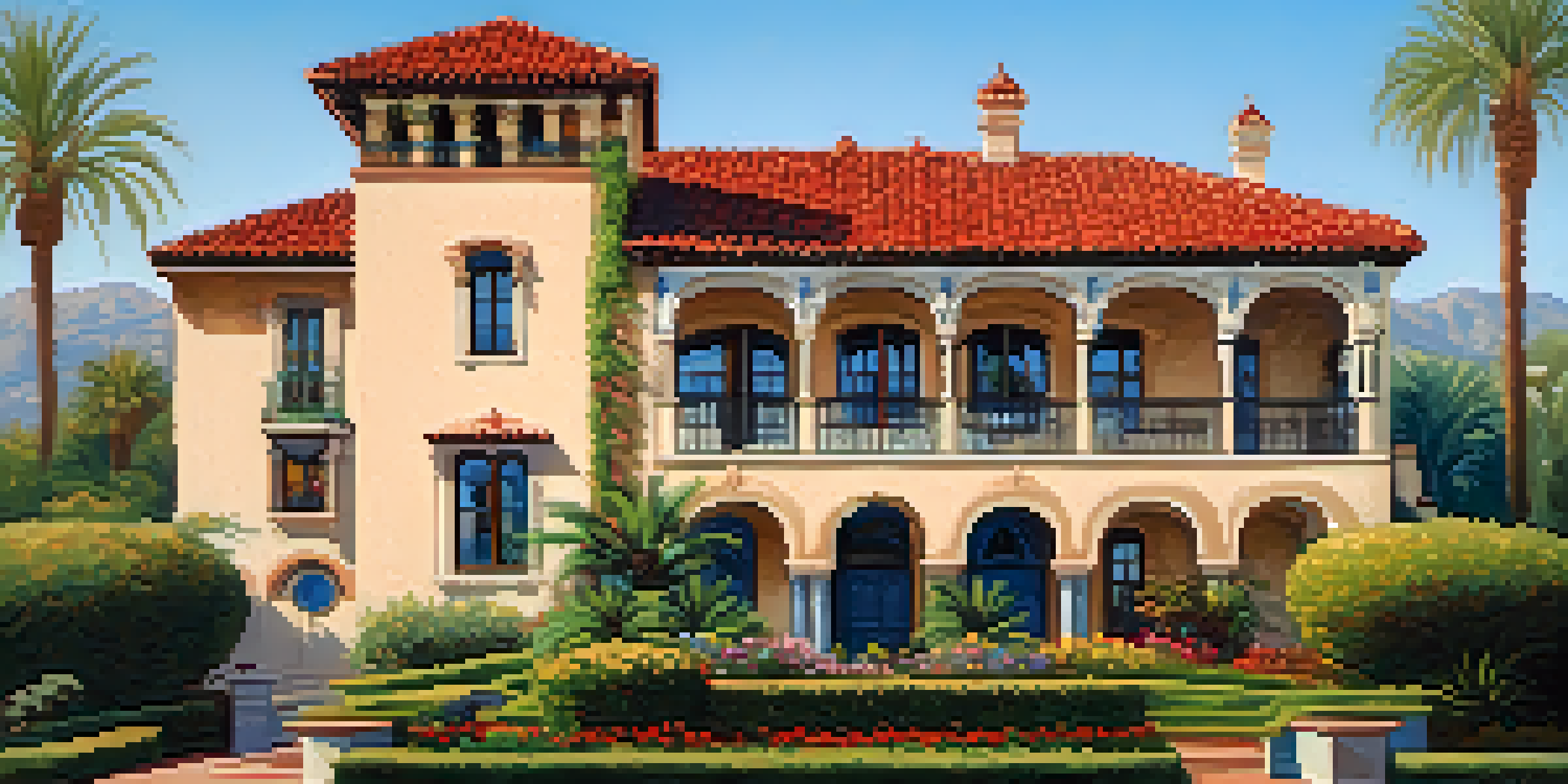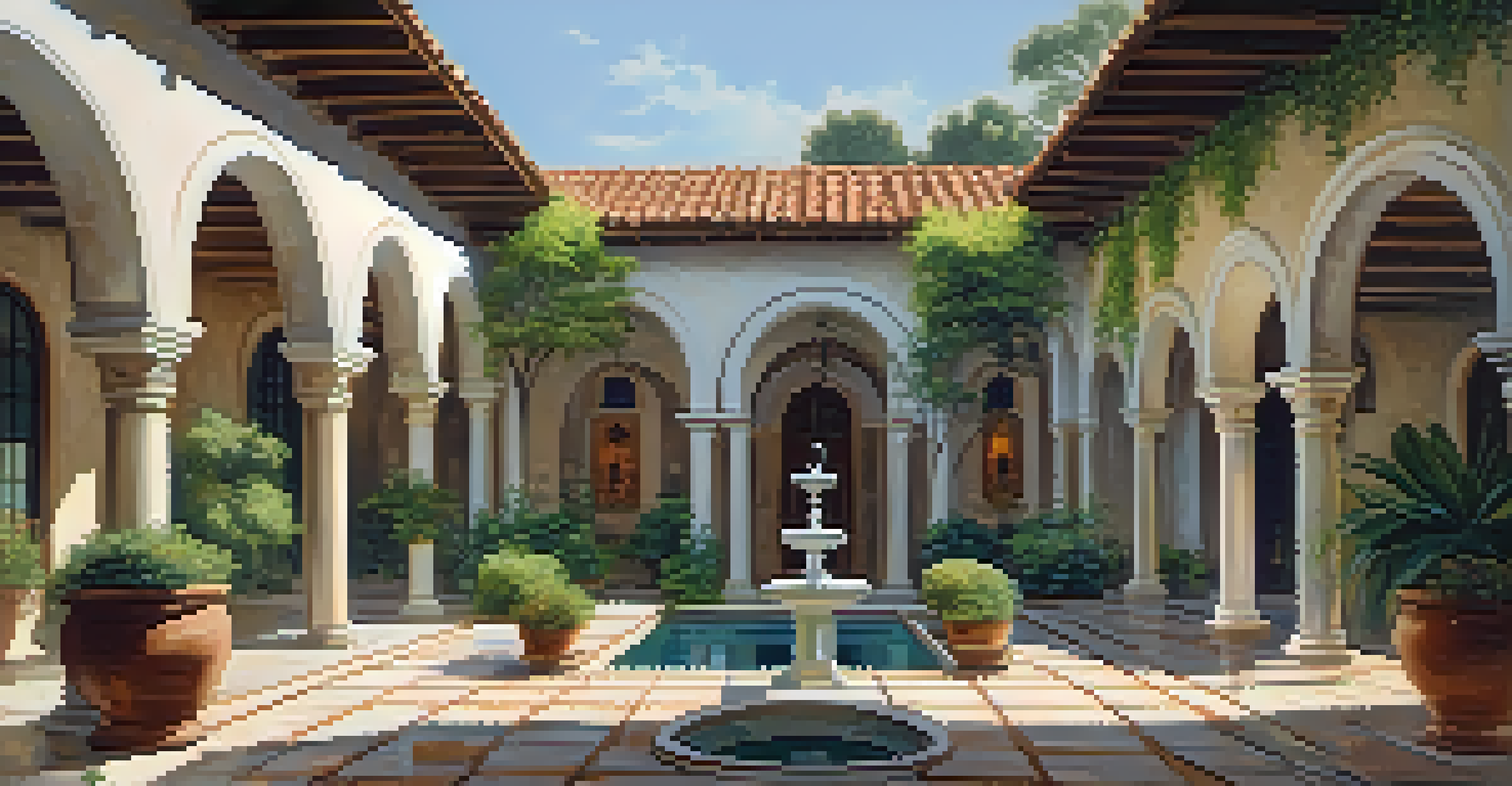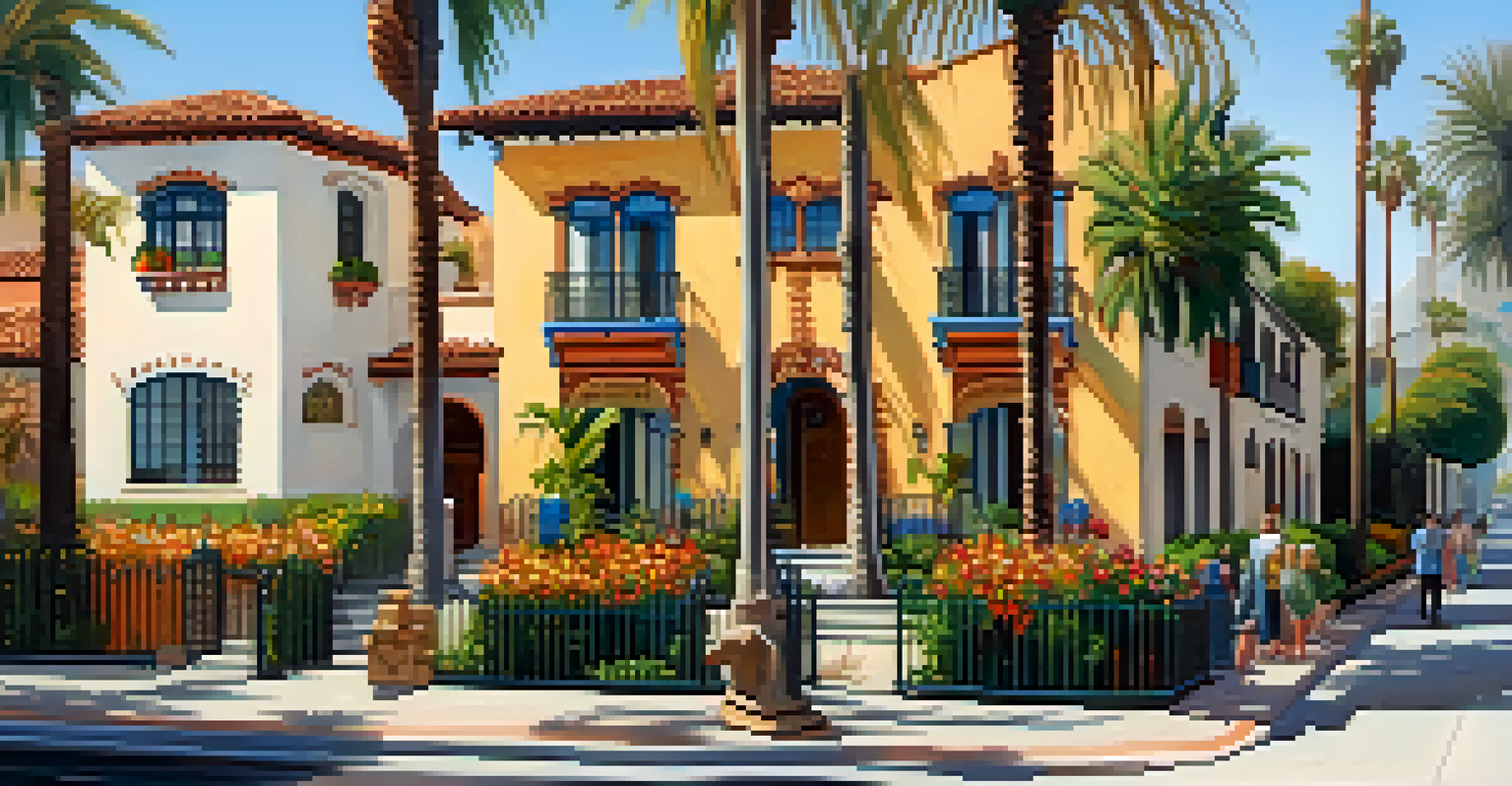The Influence of Spanish Revival on Pasadena's Landscape

Understanding Spanish Revival Architecture in Pasadena
Spanish Revival architecture emerged in the early 20th century, drawing inspiration from Spain's rich cultural heritage. This style is characterized by its stucco walls, red-tiled roofs, and intricate wrought iron details. In Pasadena, it became a significant architectural movement, giving the city a distinct aesthetic that still captivates visitors today.
Architecture is the art of how to waste space.
The allure of Spanish Revival can be seen in many iconic structures, such as the Pasadena City Hall and the Pasadena Playhouse, each showcasing unique elements of this style. These buildings not only embody the romanticism of Spanish architecture but also reflect the cultural melting pot that is Southern California. The style's warm colors and inviting designs contribute to the overall charm and character of the city.
As we explore Pasadena's landscape, it's essential to recognize how Spanish Revival architecture has influenced the urban environment. This style creates a harmonious blend with nature, often incorporating lush gardens and courtyards that enhance the outdoor experience, making Pasadena truly one-of-a-kind.
Key Features of Spanish Revival Architecture
Spanish Revival architecture boasts several defining features that set it apart from other styles. Notable characteristics include arched doorways, tiled patios, and decorative ceramic tiles that often highlight the artistry of Spanish artisans. These elements create a sense of warmth and tradition, inviting people to appreciate the craftsmanship involved.

Another significant aspect is the use of wrought iron accents, which add a touch of elegance and intricacy to the buildings. From railings to light fixtures, these details enhance the aesthetic, making each structure feel unique and personalized. This attention to detail is what makes Spanish Revival architecture so captivating.
Spanish Revival's Unique Features
Spanish Revival architecture in Pasadena is characterized by stucco walls, red-tiled roofs, and intricate wrought iron details that reflect its rich cultural heritage.
In Pasadena, these features are not just limited to public buildings; they also extend to residential homes. Many neighborhoods showcase beautiful examples of Spanish Revival architecture, allowing residents and visitors alike to experience the enchanting atmosphere it creates throughout the city.
Historical Context of Spanish Revival in Pasadena
The rise of Spanish Revival architecture in Pasadena can be traced back to the early 1900s, a time when the city was experiencing rapid growth and development. Influenced by the Arts and Crafts movement, architects sought to create a style that celebrated heritage while embracing modernity. This was the birth of the Spanish Revival phenomenon.
A building has two lives. The one it lives and the one it should live.
During this period, many prominent architects, like Myron Hunt and Elmer Grey, played a pivotal role in shaping Pasadena's architectural landscape. Their designs incorporated Mediterranean elements, inspired by both historical and contemporary influences, creating a unique blend that resonated with the local community. This architectural evolution was instrumental in establishing Pasadena as a cultural hub.
As a result, the Spanish Revival style became synonymous with the city's identity, attracting tourists and new residents alike. The architecture served not only as a visual representation of Pasadena's history but also as a testament to its vibrant, diverse culture that continues to thrive today.
The Impact of Spanish Revival on Pasadena's Urban Design
Spanish Revival architecture has significantly influenced Pasadena's urban design, shaping not just individual buildings but also entire neighborhoods. The layout often emphasizes community interaction, with open plazas and public spaces that encourage social gatherings. This design philosophy fosters a sense of belonging among residents.
Moreover, the integration of natural elements is a hallmark of Spanish Revival, with lush gardens, fountains, and courtyards seamlessly blending with the architecture. These features enhance the overall aesthetic and provide an oasis for relaxation and reflection amidst the urban hustle. It's no wonder that many people are drawn to Pasadena for its picturesque surroundings.
Impact on Urban Design
The architecture fosters community interaction through open spaces and integrates natural elements, enhancing Pasadena's picturesque environment.
Even today, this architectural style informs new developments in Pasadena. Modern architects often draw inspiration from Spanish Revival elements, ensuring that new structures complement the historical context and maintain the city's unique charm. This ongoing dialogue between old and new keeps Pasadena's landscape vibrant and dynamic.
Preservation Efforts for Spanish Revival Structures
As the years go by, the preservation of Spanish Revival structures in Pasadena becomes increasingly vital. Many of these buildings hold historical significance, representing the architectural trends of their time. Efforts to maintain and restore these sites ensure that future generations can appreciate their beauty and cultural importance.
Local organizations and community members actively engage in preservation initiatives, often collaborating with city officials to protect these architectural gems. This includes securing funding for restoration projects and raising awareness about the value of preserving Pasadena's unique heritage. Their dedication helps maintain the city's identity and charm.
Additionally, preservation efforts foster a sense of pride among residents, encouraging them to cherish the historical aspects of their community. By valuing the past, Pasadena can continue to celebrate its architectural legacy while embracing modern developments that respect this rich history.
Tourism and Spanish Revival in Pasadena
The Spanish Revival architecture in Pasadena has become a significant draw for tourists, who flock to the city to admire its stunning buildings and vibrant neighborhoods. Iconic landmarks such as the Huntington Library and the Norton Simon Museum showcase Spanish Revival elements, offering visitors a glimpse into the city's rich architectural history. These sites not only provide cultural enrichment but also contribute to the local economy.
Guided tours highlighting the Spanish Revival architecture have also gained popularity, allowing visitors to immerse themselves in the city's history. These tours often include detailed explanations of the architectural features, historical anecdotes, and insights into the lives of the architects who shaped Pasadena. This engaging approach helps foster a deeper appreciation for the style.
Ongoing Preservation Efforts
Local organizations actively work to preserve Spanish Revival structures, ensuring their historical significance and cultural importance are maintained for future generations.
As tourism continues to grow, the city recognizes the importance of preserving its architectural heritage while accommodating visitors. This balance ensures that the charm of Spanish Revival architecture remains intact, allowing Pasadena to thrive as a cultural destination.
The Future of Spanish Revival in Pasadena
Looking ahead, the future of Spanish Revival architecture in Pasadena remains bright. As the city evolves, there is a growing interest in blending traditional styles with contemporary design, creating new interpretations of the Spanish Revival aesthetic. This approach not only honors the past but also allows for innovation in architecture.
Emerging architects and designers are increasingly inspired by Spanish Revival elements, seeking to incorporate them into modern projects. This fusion of styles ensures that the spirit of Spanish Revival continues to thrive while adapting to the needs of a changing community. It creates a dynamic architectural landscape that reflects Pasadena's diverse population.

Ultimately, the lasting influence of Spanish Revival on Pasadena's landscape underscores the importance of preserving cultural heritage. By fostering a dialogue between the past and present, the city can celebrate its architectural legacy while paving the way for future generations to enjoy the unique charm that defines Pasadena.